After creating a lot of hype, OnePlus unveiled the OnePlus 5 last month. The company also launched the OnePlus 5 immediately after two days in India. The OnePlus 5 is successor to last year’s OnePlus 3T which was a mid-cycle refresh. OnePlus is known to offer top-end specs in its flagships at a price lower than the other flagships that are available in the market with similar hardware, and, the OnePlus 3 and 3T were no exception. However, this time around, OnePlus has tried to up the ante by sticking to the same strategy, but, with the inclusion of dual camera at the back. Well, does this help the OnePlus 5 stand out from other flagships and make it worthy of being called a “flagship killer” ? Let’s find that out with this OnePlus 5 review.
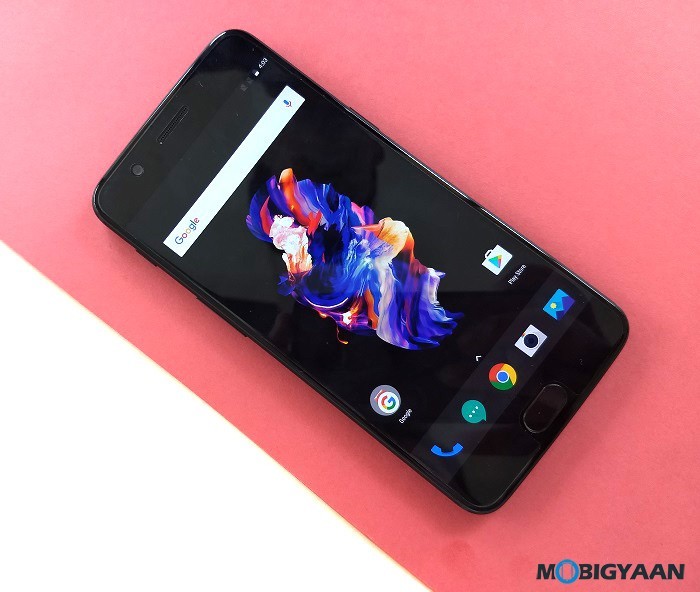
In box contents
- OnePlus 5
- Dash Charger
- USB Type-C Cable
- SIM Tray Ejector
- Screen Protector (pre-applied on the phone)
- Safety Manual
- User Guide
- OnePlus Brand Decals
OnePlus 5 specifications:
- CPU: Up to 2.45 GHz Snapdragon 835 octa-core processor based on 10 nm process
- RAM: 6/8 GB LPDDR4X
- GPU: Adreno 540
- Operating System: OxygenOS 4.5.5 based on Android 7.1.1 Nougat
- Display: 5.5-inch Full-HD (1920 x 1080 pixels) Optic AMOLED display with 2.5D curved glass, Gorilla Glass 5, DCI-P3 color coverage and 401 ppi pixel density
- Rear Camera: 16 MP (Sony IMX 398 with DCAF, f/1.7 aperture, 1.12 µm pixel size and Electronic Image Stabilization) + 20 MP (Sony IMX 350 with PDAF, f/2.6 aperture, 1.0 µm pixel size and telephoto lens) with Portrait Mode, Pro Mode, Smart Capture, RAW image capture, 4K video recording and dual-tone LED flash
- Front Camera: 16 MP Sony IMX 371 with f/2.0 aperture, 1.0 µm pixel size, Electronic Image Stabilization, Screen Flash, Smile Capture, Full-HD video recording and Face Beauty
- Internal Storage: 64 GB (with 6 GB RAM), 128 GB (with 8 GB RAM) UFS 2.1 2-Lane
- SIM: Dual SIM (Nano + Nano)
- Connectivity: 4G VoLTE, GPS, Bluetooth 5.0, NFC, CAT12/3CA, 2×2 MIMO, Wi-Fi 802.11 a/b/g/n/ac USB Type-C, 3.5 mm headphone jack, USB OTG
- Other: Fingerprint Scanner with Ceramic coating, Dirac HD Sound®, Dirac Power Sound® and support aptX & aptX HD Bluetooth audio codec
- Colors: Slate Gray (6 GB RAM + 64 GB storage), Midnight Black (8 GB RAM + 128 GB storage)
- Battery: 3300 mAh with Dash Charge technology
Design
The OnePlus 5, like its predecessor, flaunts a uni-body metal construction which is made out of aluminium. The smartphone weighs 153 grams and is 7.25 mm thin which makes it the thinnest OnePlus flagship to date. However, even though it’s the thinnest OnePlus flagship to date, it still is as sturdy as the OnePlus 3/3T.
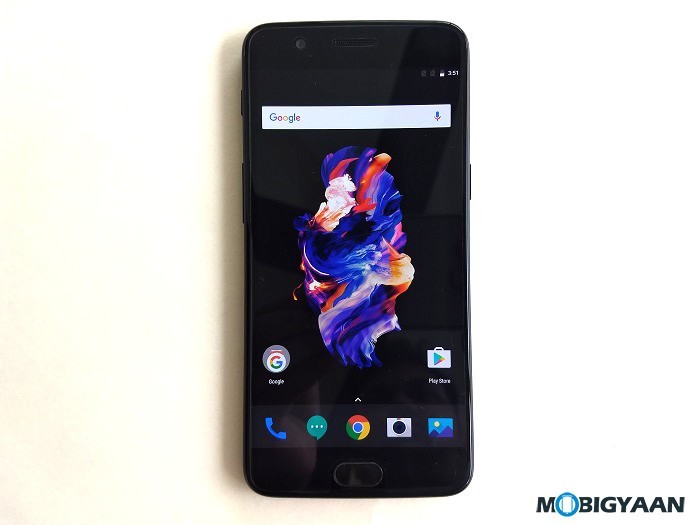
Besides, the OnePlus 5 looks similar to the OnePlus 3/3T from the front and sports the same 5.5-inch Full-HD Optic AMOLED panel which is now protected by 2.5D Gorilla Glass 5. However, even though it looks similar to its predecessor from the front, the edges are more curved from all the four sides.
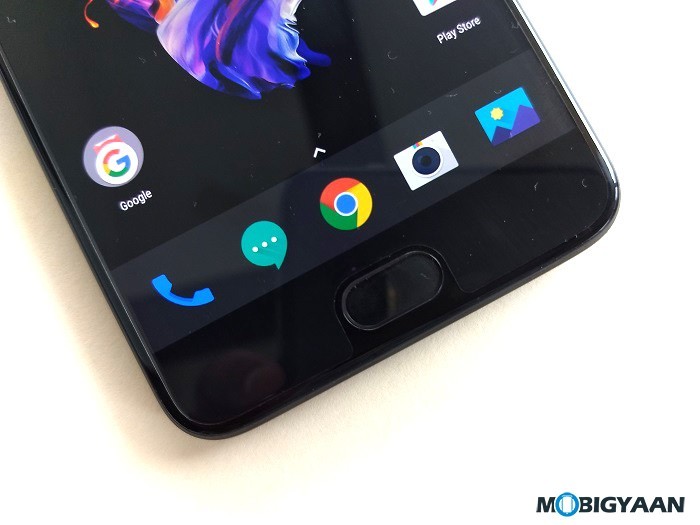
Above the panel is the earpiece, 16 MP secondary camera and LED notification light. Below the display is the home button which houses the ceramic coated fingerprint scanner flanked by capacitive navigation keys. Although these keys are backlit, they are pretty much dim and turn off quickly.
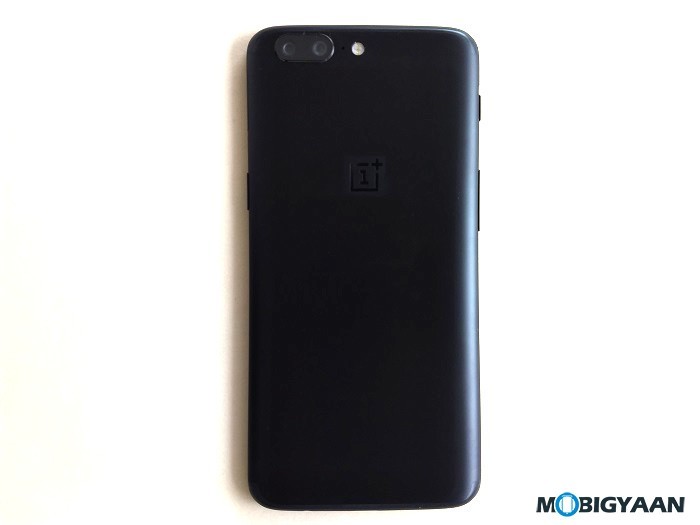
Having said that, the real deal in terms of design is the OnePlus 5’s back. At first glance, the OnePlus 5 looks similar to the iPhone 7 Plus because of the dual rear cameras located at the top-left corner of the device. The one to left is the 16 MP snapper whereas the one to right is the 20 MP snapper which comes with telephoto lens for capturing distant objects without any significant loss in detail.
The dual camera module is accompanied by primary mic and dual-tone LED flash. You can also notice the OnePlus moniker at the center below the camera module, and, you might also notice that the antenna bands have been further pushed to top and bottom of the device and aren’t visible easily.
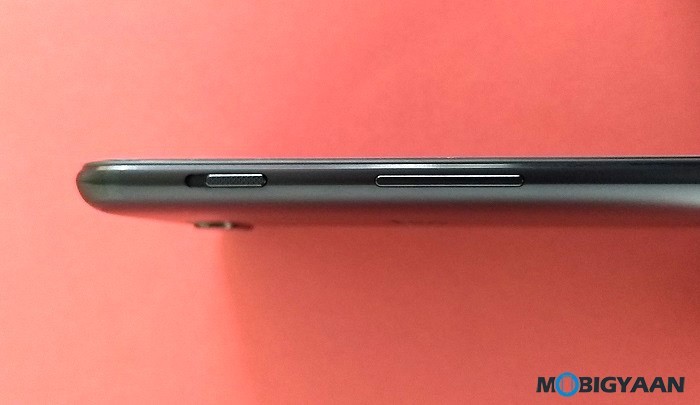
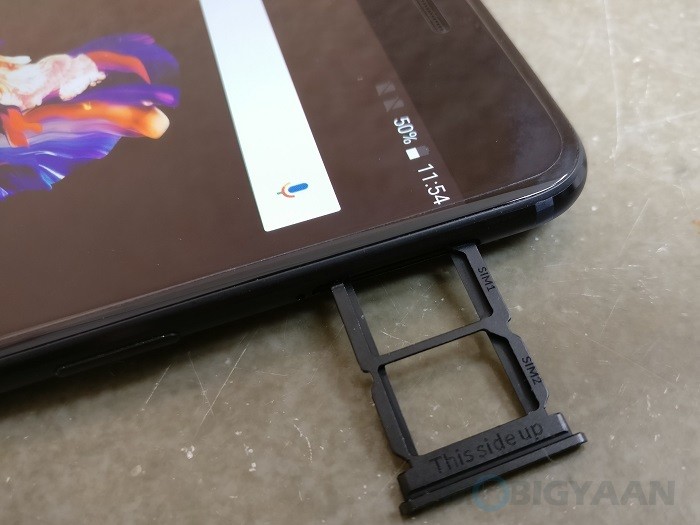
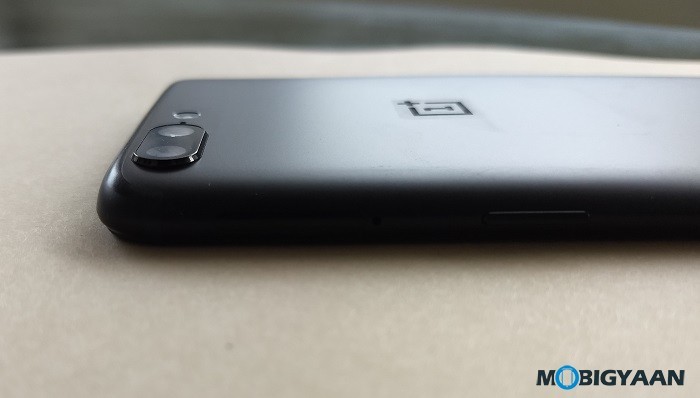
While OnePlus has made some design changes this time, the company has retained some elements from the past flagships. To be more clear, the Alert Slider and volume rocker are still at the left side of the device and the power button and SIM card slot sit to the right. The SIM slot isn’t hybrid though which means there’s no option for storage expansion, however, you can insert two nano SIM cards, and, both the slots are 4G ready.
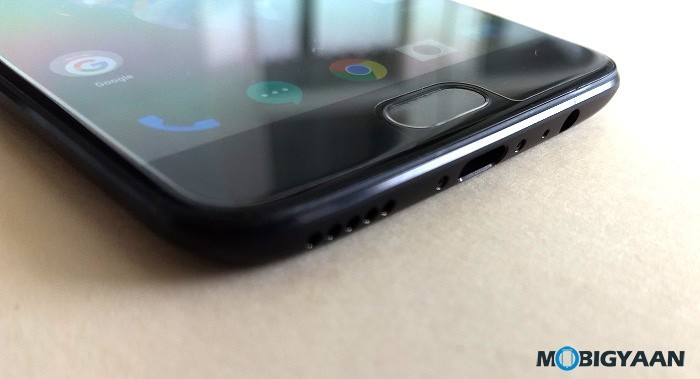
The top of the OnePlus 5 is devoid of anything, however, at the bottom, you will find the USB Type-C port which is flanked by speaker grille, primary mic, and thankfully, the 3.5 mm headphone jack.
More importanly, even though the OnePlus 5 looks similar to the iPhone 7 Plus, it actually looks the same as OPPO’s R11. Yes, the company which owns OnePlus. Moreover, the OnePlus 5 feels much more compact and comfortable to hold in hand. Thanks to the curved edges and rounded corners.
Display
The OnePlus 5 sports a 5.5-inch Full-HD (1920 x 1080 pixels) Optic AMOLED display. It comes with 2.5D curved glass along with the protection of Gorilla Glass 5, and, has a pixel density of 401 ppi.
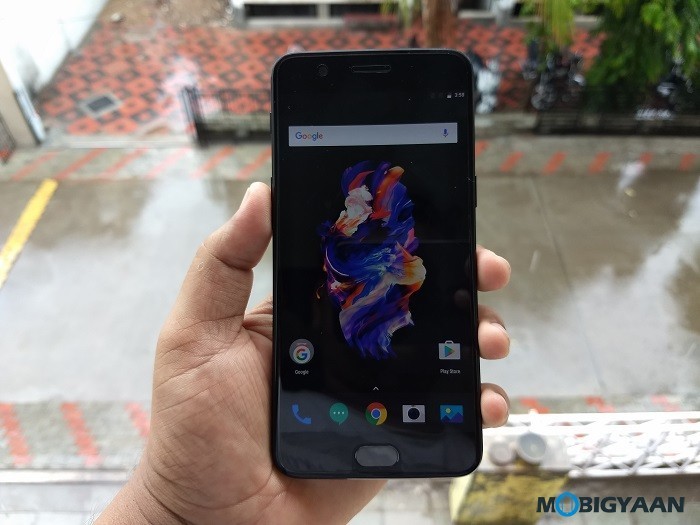
The display on the OnePlus 5 is good and bright enough and produced deep blacks. We didn’t have much problems viewing the content on the screen in sunlight. The colors reproduced were good and the text was also crisp enough. Playing games and watching videos was also fun. Besides, the viewing angles were also great unless you watch the content on the screen from weird angles. All in all, OnePlus has used the same display here that was used in the OnePlus 3T.
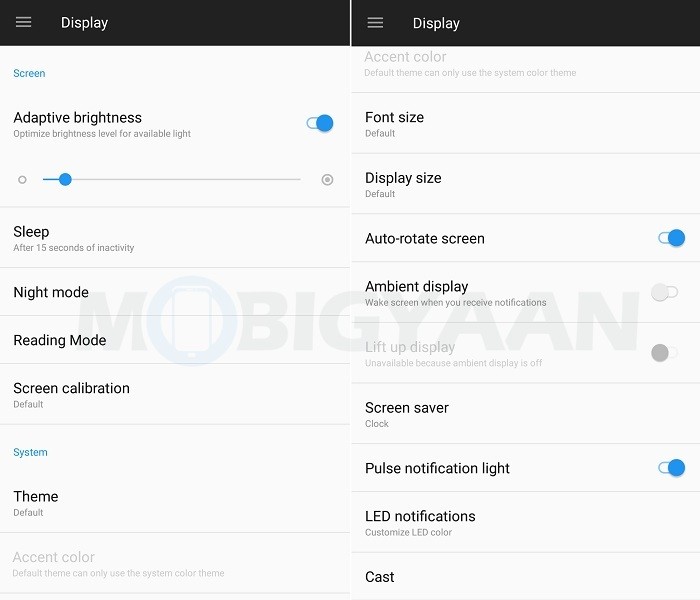
Well, even though the company has used the same panel that was found on the OnePlus 3T, it has added some useful features that enhance the user experience. The device comes with Ambient Display which wakes up the screen to show notifications. Besides, it also comes with Night Mode and Reading Mode.
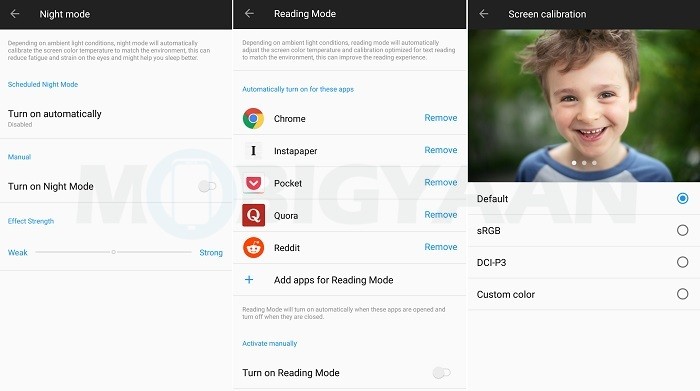
The Night Mode is already found on the OnePlus 3/3T, however, it can now be turned on/off automatically at sunset and sunrise, or, at at a specific time. The coolest addition though is the Reading Mode, which turns the screen of the OnePlus 5 to grayscale which offers reading experience similar to that on a Kindle. Moreover, it also adjusts the color temperature of the screen based on the lighting conditions using the ambient light sensor.
Like the Night Mode, the Reading Mode can also be turned on automatically, however, instead of triggering it automatically at a specific time, it can be turned on/off automatically when you open and close a specific app. Apart from the addition of these two modes, OnePlus has also added a display profile called DCI-P3 which offers a wide color gamut as compared to the sRGB mode.
Having said all that, the display on the OnePlus 5 is marred by what’s called ‘jelly’ effect. Well, the jelly effect is the one which causes the text on the display to stack up together and then stretch out. Not all of the units are having this issue, however, we noticed this on our review unit. While that’s not much of a big deal and you may get used to it after prolonged usage of the phone, it’s definitely something we didn’t like at all. You can read more about the ‘jelly’ effect here.
Fingerprint Scanner
Like we have already said, the OnePlus 5 comes with a fingerprint scanner at the front which is housed on the home button. The fingerprint scanner comes with a coating of ceramic and is a hair wider than the one on the OnePlus 3/3T.

The fingerprint scanner is pretty fast and accurate. It unlocked the phone almost instantaneously and the only time it failed to recognize the fingerprint was when my fingers were wet, but that was only once or twice. Apart from that, our experience was very much pleasant when it came to unlocking the OnePlus 5 using the fingerprint scanner.
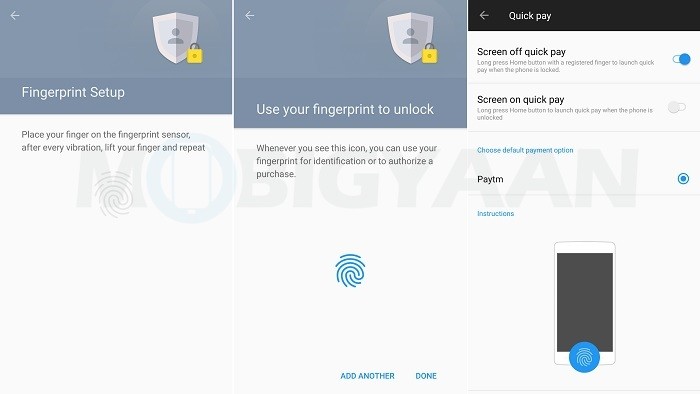
Having said that, apart from using the fingerprint scanner to unlock the phone, it can also be used to make a quick payment using the Paytm app. To do so, you will have to enable the Quick Pay option from the Settings > Security & fingerprint > Quick pay menu. Once enabled, you can quickly launch Paytm’s payment screen by long pressing the home button.
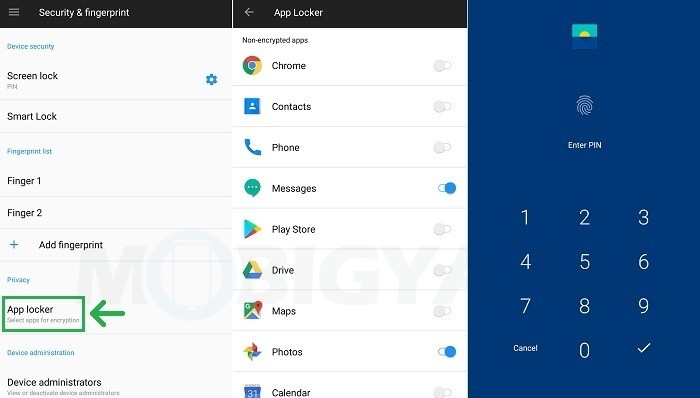
Moreover, the fingerprint scanner can also be used to lock the apps. It can be enabled from the Settings > Security & fingerprint > App locker menu. Once done, the locked apps will only be accessed using the registered fingerprint (apart from the security PIN, of course).
Performance
The OnePlus 5 is powered by Qualcomm’s flagship Snapdragon 835 SoC which is paired with 6 or 8 GB RAM and backed up by Adreno 540 GPU. The Snapdragon 835 SoC is clocked up to 2.45 GHz and consists of eight Kryo 280 CPU cores. The chipset is also based on 10 nm process which helps it stay fast and cool while gulping less battery.
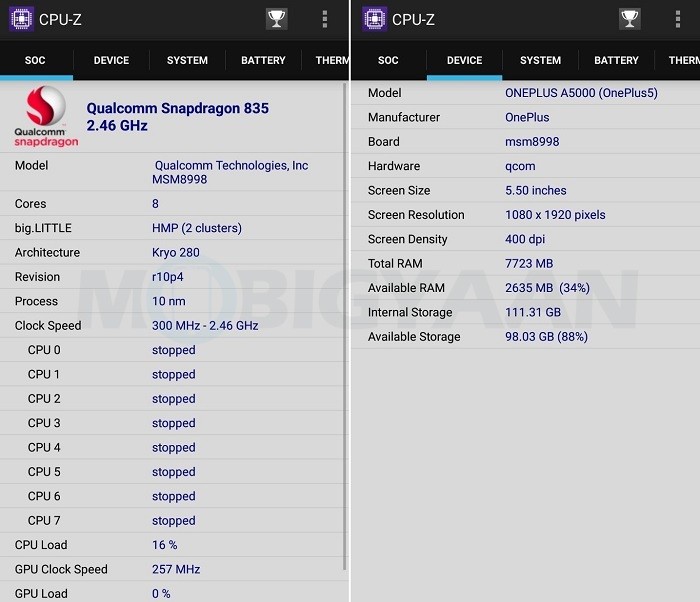
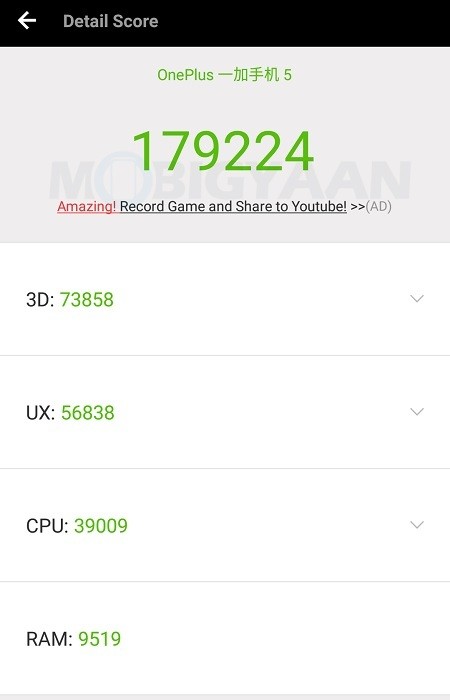
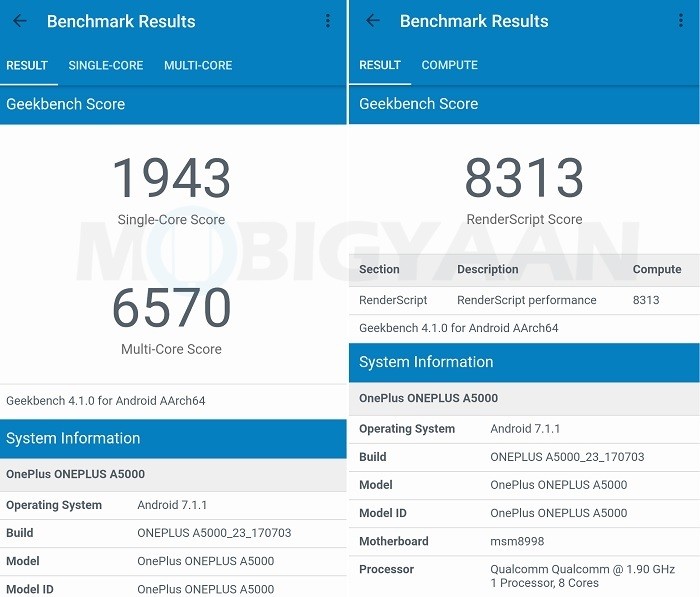
Our review unit came with 8 GB RAM and 128 GB internal storage. It scored 1,79,224 points in AnTuTu test while scoring 1943 and 6570 points in Geekbench 4’s single and multi-core tests respectively. The device also scored an impressive 8313 points in Geekbench 4’s Compute test. Here are the full stats of Geekbench 4 CPU and Compute test of OnePlus 5.
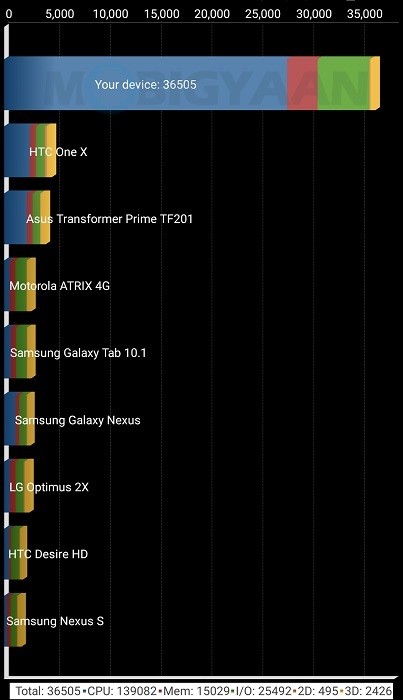
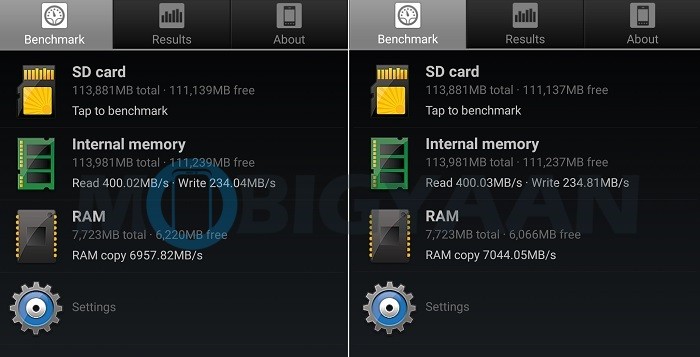
The phone also scored 36,505 points in Quadrant Standard Edition benchmark test. The OnePlus 5 comes with LPDDR4X RAM which the company said was power efficient. Well, based on our benchmark tests, we found out that the RAM is pretty much fast with an average copy speed of 7000 MB/second.
Well, having said all that, let us remind you that these are just synthetic tests. Besides, OnePlus was again caught cheating on the benchmarking apps with the OnePlus 5. But, let us also be clear that this cheating was unnecessary as in our real world test based on daily usage, the OnePlus 5 performed like a champ.
The OnePlus 5 is just buttery smooth when it comes to performance, and, the credit for that goes to the Snapdragon 835, ample amount of RAM and OxygenOS, which is close to stock Android. It handled everything we threw at it like a boss. At all the times during our review period, we had around 32-33 apps in the background, and, never did this phone stutter. Not even once. Switching between the apps was also smooth. No lags whatsoever.
Gaming on the OnePlus 5 was a pleasure as well. It ran all the games with ease without any lags. We tested heavy titles like NFS No Limits, N.O.V.A. 3: Freedom Edition and Asphalt 8 on this phone with more than 30 apps in background, and this phone performed with flying colors. Of course, there were frame drops once or twice while playing the Asphalt 8, but, that was at the highest setting with 30+ apps and games in the background. Adreno 540 GPU also did a pretty good job at rendering the graphics in the games and we just loved it.
Games we tested on OnePlus 5
- N.O.V.A. 3: Freedom Edition
- Asphalt 8
- NFS No Limits
- Traffic Rider
We also played these games for extended sessions and the phone managed to stay cool at under 40-degree Celsius. Again, the credit for this goes to the Snapdragon 835 SoC which is based on 10 nm process. It churns out the maximum performance while sipping less battery and helping the device remain cool.
To sum up, there’s nothing that you should worry about the OnePlus 5 when it comes to daily usage, be it scrolling through social media apps like Facebook or Instagram, or, gaming your way through resource intensive titles. This phone handles it all without any hiccups.
Software
The OnePlus 5 runs OxygenOS 4.5 out of the box which is based on Android 7.1.1 Nougat, however, by the time we started reviewing it, it was running OxygenOS 4.5.5 and was on May 1, 2017 security patch for Android. Besides, we spent majority of our time reviewing the OnePlus 5 on OxygenOS 4.5.5 update.
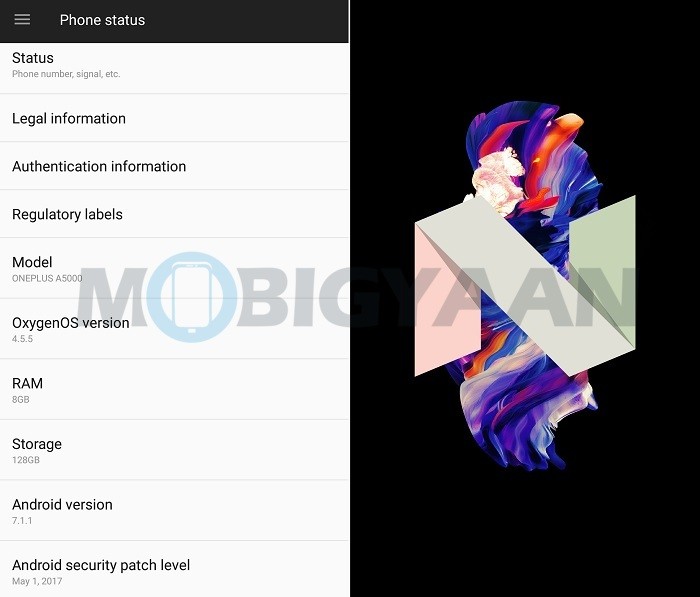
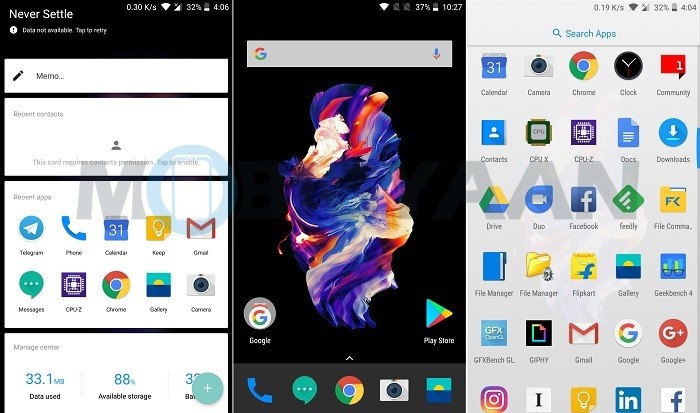
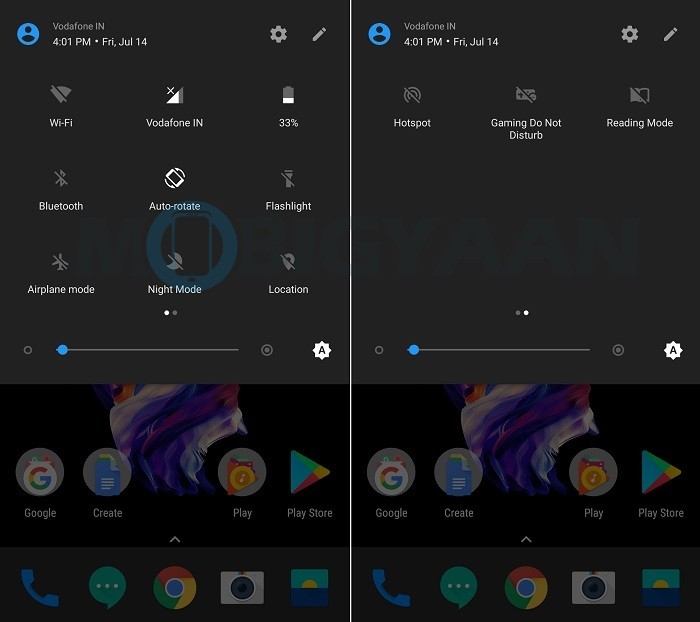
Like we already mentioned, the OxygenOS is near stock Android and devoid of any bloatware (it does come pre-installed with apps like Amazon Kindle, Amazon Shopping, Amazon Prime Video and OnePlus Community though). However, it does come with some useful customizations which enhance the user’s experience. The UI is close to stock Android and the app icons are now relatively smaller. The OnePlus 5 also comes with a Pixel-like launcher, and hence, there’s no app drawer icon now. To access any apps, you will have to swipe up on the homescreen.
Like the previous OnePlus flagships, the OnePlus 5 also comes with Shelf which can be accessed by swiping from left to right on the homescreen. It shows information like most contacted people, most used apps as well some other handy information like the amount of data used, available storage and the battery level. Of course, you can also customize the Shelf to your liking by adding or removing the widgets.
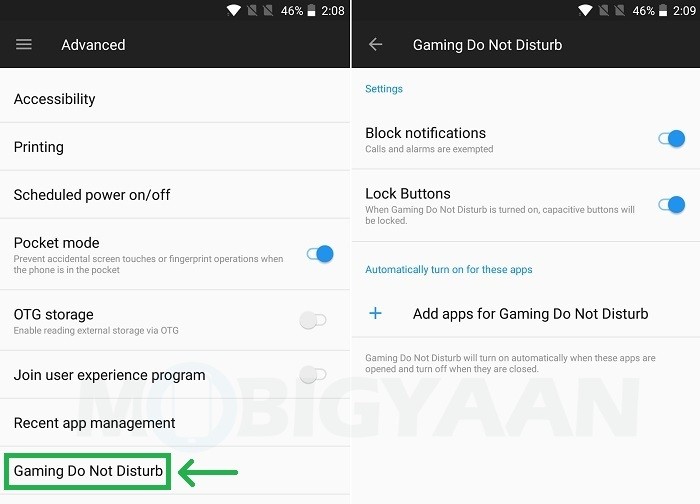
The OnePlus 5 comes with Reading Mode and improved Night Mode now, which we have already discussed about in the Display section. Other useful features it comes with is the Gaming Do Not Disturb mode which blocks notifications while you are gaming. Of course, you can also set it up to block notifications while you are using any apps (which aren’t games). You can go to the Settings > Advanced > Gaming Do Not Disturb menu to set it up to your liking.
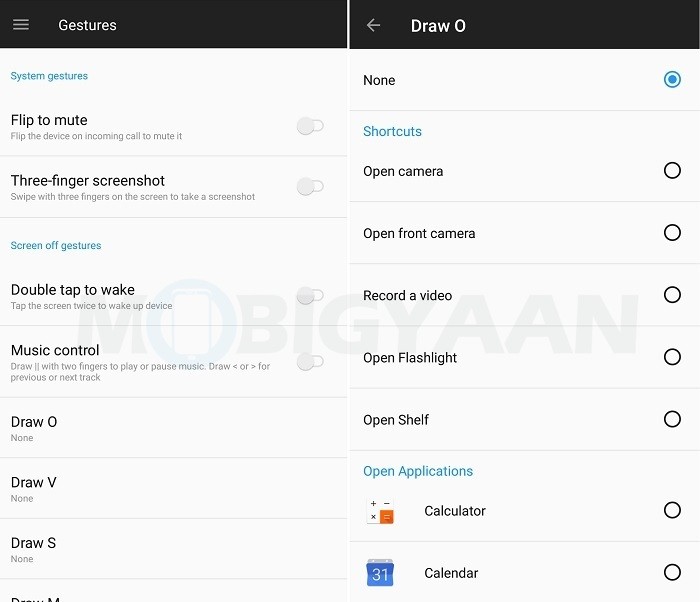
The evergreen gestures are back, but this time, with some improvements. Gestures like flip-to-mute, three-finger screenshot, double-tap to wake and music control, which we have seen in previous flagships, are included, however, you can now draw the letters O, V, S, M and W on the screen to open any pre-defined shortcuts or launch your favorite apps. You can tinker around with the gestures by going to the Settings > Gestures menu.
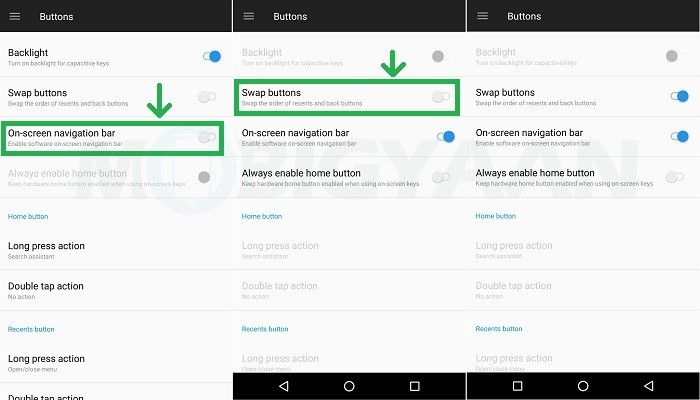
The OnePlus 5, like the OnePlus 3/3T, comes with backlit capacitive navigation buttons which act as back and recent apps button. However, if you don’t like them, you can disable them and switch to on-screen navigation buttons. Moreover, on-screen or off-screen, you can swap their positions as well. Apart from that, you can also customize the long-press and double-tap actions for all three buttons. All these options can be found under the Settings > Buttons menu.
Camera
The biggest highlight of the OnePlus 5 is the dual camera setup at the back which consists of a combination of 16 MP and 20 MP cameras accompanied by dual-tone LED flash. The former is a regular camera whereas the latter comes with telephoto lens to help you take images of distant objects without any loss in quality. At the front, there’s a 16 MP camera which comes with a feature called Screen Flash to help you take brighter photos in low-light conditions.
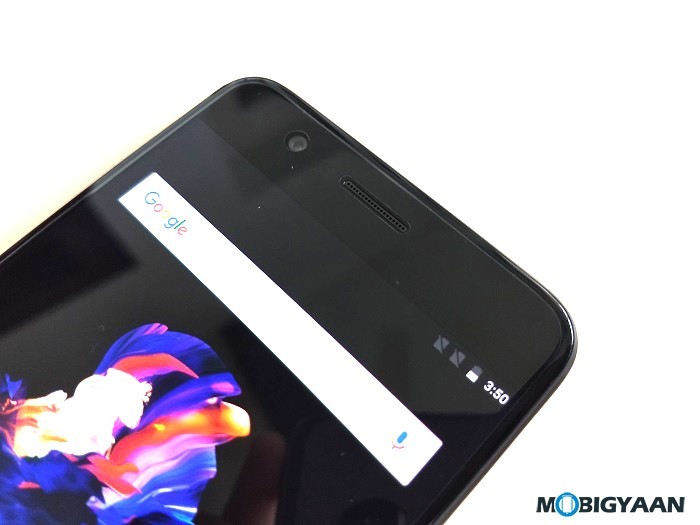
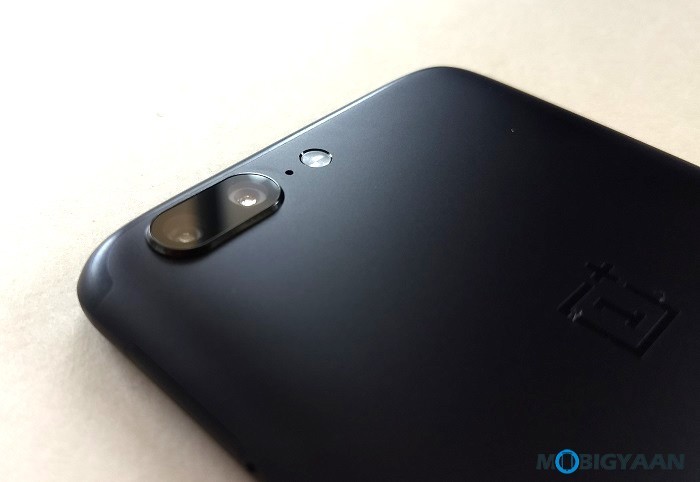
OnePlus 5 Camera specifications:
- Rear Camera: 16 MP (Sony IMX 398 with DCAF, f/1.7 aperture, 1.12 µm pixel size and Electronic Image Stabilization) + 20 MP (Sony IMX 350 with PDAF, f/2.6 aperture, 1.0 µm pixel size and telephoto lens) with Portrait Mode, Pro Mode, Smart Capture, RAW image capture and dual-tone LED flash
- Rear Camera Video Recording: 4K video up to 10 minutes at 30 frames/second, 1080p video with Electronic Image Stabilization at 30 and 60 frames/second, 720p video at 120 frames/second, Time-lapse up to 1080p, Slow motion up to 720p at 120 frames/second
- Front Camera: 16 MP Sony IMX 371 with f/2.0 aperture, 1.0 µm pixel size, Electronic Image Stabilization, Screen Flash, Smile Capture and Face Beauty
- Front Camera Video Recording: 1080p at 30 frames/second, 720p at 30 frames/second and Time-lapse
The rear cameras can capture images at a maximum resolution of 4608 x 3456 pixels, and at 5184 x 3880 pixels with 2x “lossless” zoom, whereas, the video can be recorded in up to 4K resolution (3840 x 2160 pixels). However, the 4K video can only be recorded for up to 10 minutes at a time, and, the Electronic Image Stabilization is only available for 1080p and 720p resolution videos which is a downer.
Well, that was the UI of the camera app, and, as you can see, it’s pretty much bare-bones with very few options. Now let’s take a look at the daylight shots taken from the OnePlus 5.
Click on any image above to enlarge it.
Now let’s take a look at the images taken during night time.
Click on any image above to enlarge it.
The images taken from the 16 MP rear camera during daylight did turn out to be beautiful and colors were true-to-source most of the times. The sensor also captured the details pretty decently and EIS made sure that the images were blur-free. The EIS did a pretty good job, and, there’s one evening shot which turned out to be better than expected as it was captured while we were in a car moving at around 40-45 km/hr.
Speaking of the 20 MP camera with telephoto lens, it only offers optical zoom up to 1.6x, and the rest from there is software trickery up to 2x to offer “lossless” zoom. That said, you can zoom up to 8x, however, it is digital zoom and the resulting images do turn out to be grainy.
Moreover, there were times when the color of the subject turned out to be a little different while capturing it using the 2x lossless zoom. That said, the 20 MP camera is also used to sense the depth of field to take photos in Portrait Mode with Bokeh effect. Well, speaking of the Portrait Mode, it’s more of a hit-and-miss at this time, however, that’s not something that cannot be fixed with future software updates. Having said that, we did love the photos taken in Portrait Mode, but, there were times when the edges of the subject were blurred and the background stayed in focus.
Talking about the rear camera’s performance at night, the photos captured were decent, however, in some cases, they turned out to be grainy and HDR effect didn’t help take better shots either. However, with the HDR mode on, the images did turn out to be brighter, but, had visible noise. The images taken with HDR mode during day did take bright, sharp images though. Also, the images taken with 2x zoom at night were usable, however, they did lack the sharpness.
The rear camera also comes with Pro Mode which lets you control different aspects of the camera like ISO, white balance, exposure time and more. You can also take images in RAW format with the Pro Mode. If you know what you are doing, you can take impressive images even at night by tinkering around with the camera settings in the Pro Mode.
Coming to the front camera, it did take decent images, and, it comes with smile to capture and beauty mode which smoothens your skin to make you look good. It also supports HDR mode and comes with Screen Flash to help you take brighter selfies in low-light conditions.
So, to conclude, the rear camera does take some great shots, however, the lack of OIS (which was present in OnePlus 3/3T) was a bummer. Also, we are hopeful that OnePlus will roll out a software update to make the Portrait Mode work much better.
Call Quality and Audio
The call quality on the OnePlus 5 was very decent. We were able to listen to the person at the other end clearly, and, the same way the other person was also able to listen to us clearly. Moreover, the phone also managed to latch on to the 4G network on our Vodafone SIM pretty well. Of course, there were times when it dropped to 2G network automatically, but that was due to network congestion and other issues, and not the phone’s fault.

Besides, the OnePlus 5 also supports a wide range of network bands which makes sure that it’s compatible with different carriers in most parts of the world.
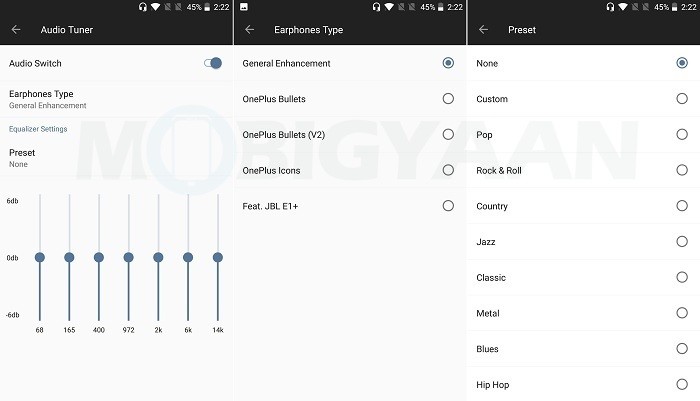
The OnePlus 5 has a speaker at the bottom, and, we must say that it’s loud enough. We never felt the need to watch videos by connecting to a speaker because of lower volume. It also comes with support for Dirac HD Sound® and Dirac Power Sound®. While the OnePlus 5 doesn’t come with it’s own music app, it does come with Google Play Music. However, you can always download your favorite music player from the Play Store.
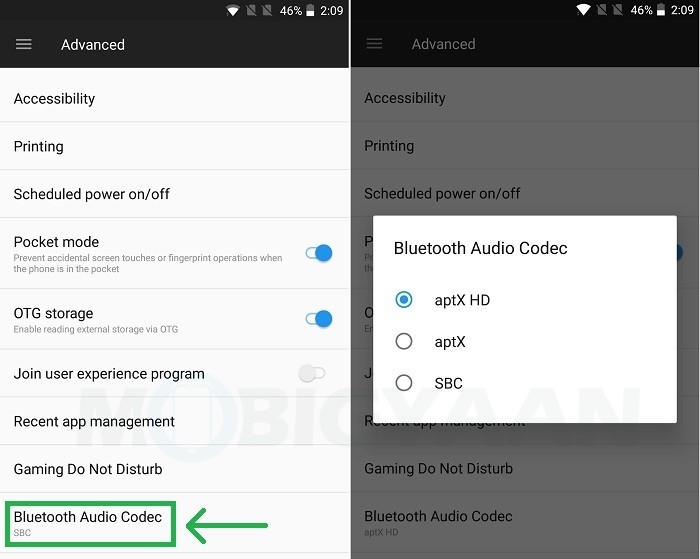
Having said that, you do get to customize the audio output coming off the connected earphones. You can select any of the available preset audio settings, or, can customize one to your liking. Moreover, the OnePlus 5 also comes with Bluetooth 5.0 which currently is only available in select flagships, and, it also supports aptX and aptX HD Bluetooth audio codecs.
You can head on to the Settings > Sound & vibration menu to tune the audio, and, can go to the Settings > Advanced > Bluetooth Audio Codec menu to select your favorite audio codec to stream music over Bluetooth heaphones.
Storage
The OnePlus 5 comes in two storage variants – 64 GB and 128 GB. The 64 GB variant comes with 6 GB RAM whereas the 128 GB variant comes with 8 GB RAM. However, neither of them come with a microSD card slot to expand the storage.
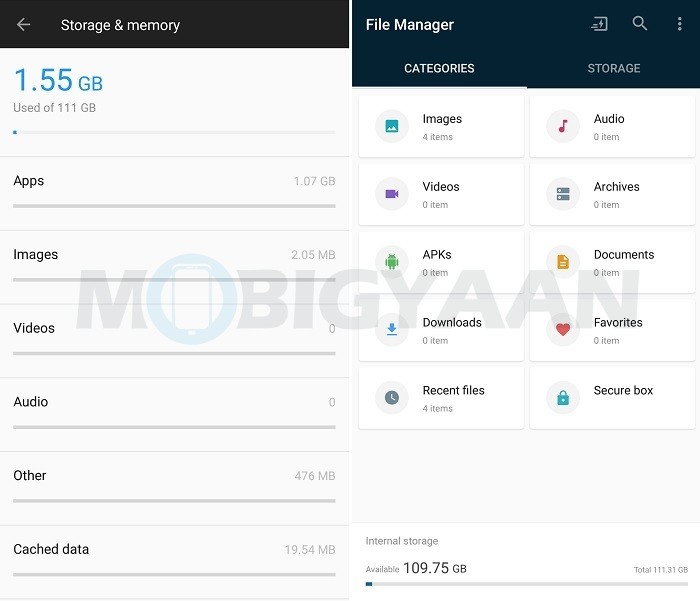
The review unit we received is the 8 GB RAM variant with 128 GB storage, however, out of the 128 GB, only 111 GB is available to the user. Besides, both the models come with UFS 2.1 2-Lane storage, and we must say that the storage is pretty fast.
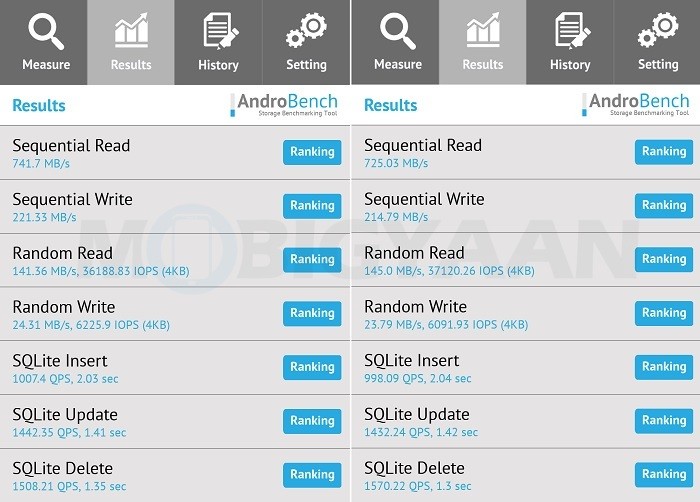
In our A1 SD Bench test, we got an average read speed of 400 MB/second and write speed of 234 MB/second. As for the AndroBench test, we saw the sequential read speed climbing up to 741 MB/second and write speed to 221 MB/second. Well, this much fast storage helps in opening the apps and games quickly which results in faster performance.
Moreover, the OnePlus 5 also comes with a native file manager which categorizes the files based on their types. We actually liked this manager as it comes with two useful features – Secure Box and FileDash. With Secure Box, you can hide the files from others, and, they can only be accessed using the security PIN or the registered fingerprint. Speaking of FileDash, it lets you send and receive files faster over a Wi-Fi connection.
Also, speaking of the storage capacity, even though the phone lacks microSD card slot, we think that even 64 GB of internal storage should suffice for most of the users out there. If not, you can go for the 128 GB variant. Besides, you can also quickly backup your files using the USB OTG feature if you run out of storage. It can be turned on by going to the Settings > Advanced menu option.
Battery
The OnePlus 5 ships with a 3300 mAh battery which is 100 mAh smaller than the one on the OnePlus 3T. Of course, like the previous flagships, the battery is user non-removable.
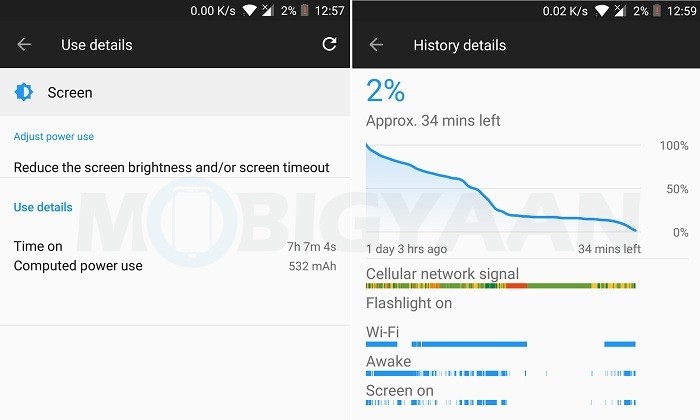
The battery life on the OnePlus 5 is pretty good. On moderate to heavy usage, it easily got us through a day with around 15-20% battery left. Our usage included playing heavy games for around 80 minutes, using apps like Facebook and Instagram, some phone calls, some tweeting, and of course, watching videos and listening to music both offline and online. Below is the table which should give you a fair idea of OnePlus 5’s battery performance.
[table id=108 responsive=flip/]
Based on the above usage, we got a solid screen-on time of 7 hours. However, on normal usage, we got screen-on time of somewhere between 4 and 5 hours with battery lasting for a day and a half with ease. That said, if you are someone who has a more heavy usage, you need not worry much as the OnePlus 5, like last year’s flagships, supports Dash Charge technology.
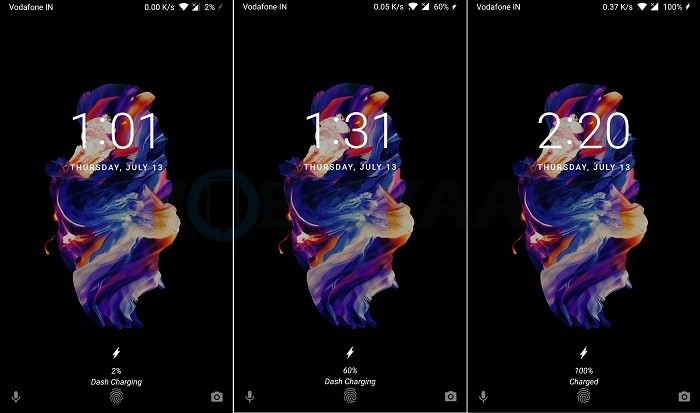
The OnePlus 5 comes with Dash Charger which has a rating of 5V/4A, giving an output of 20 W. With the Dash Charger, the OnePlus 5 charges from 0 to 60% in around 30 minutes, and, takes around 80 minutes to reach 100%. Well, this ensures that your phone is juiced up quickly to keep you going.
Having said that, Dash Charger is now much more bulkier, and, to get these charging speeds, you will have to stick to it and the charging cable that came bundled along. If you switch to some other adapter, you will miss out on these fast charging speeds.
Pricing and Variants
The OnePlus 5 is offered in two different variants:
- Slate Gray
- Midnight Black
The Slate Gray variant comes with 6 GB RAM and 64 GB internal storage, whereas, the Midnight Black variant comes with 8 GB RAM and 128 GB internal storage. The review unit we got is the Midnight Black variant.
The OnePlus 5 is available exclusively on Amazon India, however, you can also purchase it online from the OnePlus Store. Speaking of pricing, the 6 GB RAM variant is priced at ₹32,999 whereas the 8 GB RAM variant comes with a price tag of ₹37,999.
OnePlus is also selling protective cases for the OnePlus 5. There are a total of four different cases you can choose from. They are:
- Sandstone (priced at ₹990)
- Rosewood (priced at ₹1490)
- Kevlar (priced at ₹1490)
- Ebony Wood (priced at ₹1490)
We would suggest you to invest in a protective case for the OnePlus 5 as the back of the phone is slippery. Putting on a case will not only prevent it from slipping from your hands, but, should also protect it from falls.
Final thoughts
So, it’s time to wrap up our review with final thoughts. The OnePlus 5 is one hell of a beast when it comes to performance. The Snapdragon 835 SoC and 6/8 GB RAM under the hood gives it the raw power to handle anything thrown at it without breaking sweat. Couple that with the sleek, lightweight OxygenOS and you have a winner.
Speaking of the design, yes, it does look like iPhone 7 Plus at first glance, but, it actually looks much more like OPPO R11. Of course, the design doesn’t help the phone stand out from other flagships that now come with bezel-less design, and, we will say that OnePlus played a safe bet by going for this design. Having said that, it’s built well, feels sturdy and the buttons also provide tactile feedback. But, the back of the phone is slippery, hence, investing in a protective case will be a good idea.
OnePlus has stuck to the 5.5-inch 1080p panel which is exactly the same as the one on the OnePlus 3T. Well, that’s nothing bad though as the panel is still one of the best available in the market. The colors looked good, and, it now also supports DCI-P3 color coverage which offers wider color gamut. Having said that, we would have loved to see QHD panel as other OEMs are offering it for a lower price. Besides, Full-HD resolution also makes the OnePlus 5 less desirable for Daydream VR, despite of having powerful hardware at disposal.
Apart from that, there’s this jelly effect issue which cannot be fixed. We were totally unimpressed with this jelly effect as it made scrolling on the phone unpleasant. That said, there’s nothing that can be done to fix it, hence, it’s better that we ignore it and move on, and hope that OnePlus will be more careful with its next flagship if it decides to invert the display.
Talking about the software, it comes with OxygenOS 4.5 (currently on 4.5.5) which is devoid of any bloatware. It stays very much close to stock Android and has useful customizations added. If you are someone who is used to Nexus/Pixel devices, you will feel being right at home.
Speaking about the dual camera setup at the back which is the phone’s biggest highlight, we would say that the 16 MP primary rear camera performed well. As for the 20 MP camera with telephoto lens, it is only used to offer 2x lossless zoom and take photos with Bokeh effect. The bokeh effect produced in the Portrait Mode isn’t perfect though, but, we are hopeful that future software updates from OnePlus will make it work better.
Having said that, we were disappointed to see OIS given a miss, and instead, we had to rely on EIS. Moreover, the phone also doesn’t come with proper water and dust resistance (it actually does, but the company didn’t want to advertise it). Well, of course, some corners had to be cut to keep the price of the phone lower while offering powerful innards. Isn’t it?
So, should you buy the OnePlus 5?
Well, if you are currently using the OnePlus 3T or even the OnePlus 3, then we would say you skip this one. Unlike the OnePlus 3, the OnePlus 5 is more of an evolution rather than a revolution. Just some spec bumps with the inclusion of dual rear cameras.
If you are on last year’s OnePlus flagships, we would say that you are pretty much set for the rest of the year as the Snapdragon 820/821 SoC with 6 GB RAM still make the OnePlus 3/3T a viable option, and, the performance hasn’t degraded either until now.
That said, if you are a OnePlus fan, a stock Android enthusiast or someone for whom raw power matters the most, then THIS IS THE PHONE you should buy. You really won’t go wrong with the purchase decision. Besides, the phone is also said to get the Android O update before the end of this year, which is faster as compared to some other tech giants with billions of dollars and ample resources at their disposal.
Other options:
- Moto Z2 Play (₹27,999)
- Honor 8 Pro (₹29,999)
- LG G6 (around ₹40,000)
If you have decided to go for the OnePlus 5, we would advice you to go for the 6 GB RAM variant which is priced at ₹32,999 as 8 GB RAM is really an overkill at this time, even if you want a future-proof option. In our usage of the 8 GB RAM variant, we had around 32-33 apps in the background which included some resource hoggers like Facebook and heavy games like Asphalt 8, NFS No Limits and N.O.V.A. 3: Freedom Edition, and, we still had at least 2 GB of RAM free at any given time.
Also, if you want the 8 GB RAM variant, we would say it would have been a better deal if it was priced somewhere around the ₹35,000 mark as there are other phones like Honor 8 Pro which come with Kirin 960 SoC, 6 GB RAM, 128 GB internal storage, 5.7-inch Quad-HD display, 4000 mAh battery and better camera performance at night.
Then there’s also the LG G6 which though comes with last year’s Snapdragon 821, has other things going for it like bezel-less design, military grade MIL-810G certification as well as IP68 water and dust resistance. It’s now priced lower at around ₹40,000.
Pros
- Well built
- Performance beast
- OxygenOS close to stock Android with useful features added
- Display
- Good battery life
- Good Camera
- Dash Charge technology charges the phone very fast (0 to 60% in 30 minutes)
- Fast and accurate Fingerprint Scanner
Cons
- Portrait Mode needs more fine tuning
- Should have been priced a little lower as this isn’t exactly a flagship killer
- Design could have been better






























































